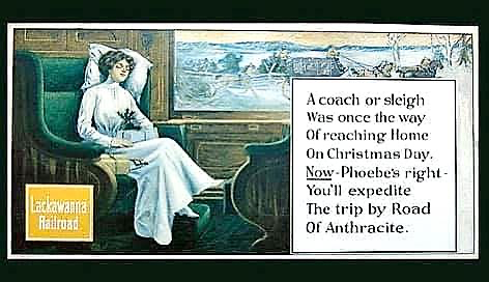Phoebe Snow in Print
- Fred Heilich
- Nov 24, 2024
- 3 min read
Updated: Nov 28, 2024
Excerpt fromThe Roustabout Issue #40 Published by the Delaware, Lackawanna, and Western Railroad Historical Society, Inc. Winter 2021
From Wikipedia, the free encyclopedia:
Phoebe Snow was a fictional character created by Earnest Elmo Calkins to promote the Delaware, Lackawanna and Western Railroad. The advertising campaign was one of the first to present a fictional character based on a live model amid impressionistic techniques. Rail travel around 1900 was tough on the clothing of passengers. After a long trip on a coal-powered train, travelers frequently would disembark covered with black soot, unless the locomotives were powered by anthracite, a clean-burning form of coal. The Lackawanna owned vast anthracite mines in Pennsylvania, and could legitimately claim that the clothes of their passengers would remain clean after a long trip.
To promote this, the Calkins advertising department created, "Phoebe Snow", a young New York socialite, and a frequent passenger of the Lackawanna. The advertising campaign presented Miss Snow as often traveling to Buffalo, New York and always wearing a white dress. Calkins said he based the campaign on an earlier series of Lackawanna car cards (advertisements displayed inside coaches) - All in Lawn - created by DL&W advertising manager, Wendell P. Colton. They had been built on a rather limiting nursery rhyme, The House That Jack Built, and featured a nameless heroine dressed in white. For his new campaign, Calkins adopted a form of verse inspired by an onomatopoetic rhyme, Riding on the Rail, that he felt offered endless possibilities.
Phoebe soon became one of the most recognized advertising mascots in the United States, and she began to enjoy all the benefits offered by DL&W: gourmet food, courteous attendants, an observation deck, even onboard electric lights.
In 1903, filmmaker Edwin Porter parodied the advertising campaign with his short film A Romance of the Rails.
"Phoebe Snow" was the only name Calkins ever used in the advertisements, and he laughed at later claims by Lackawanna officials that the name was selected only after lengthy scientific experimentation. The original artwork was painted by Henry Stacy Benton, who worked from a series of images of a model, Marion Murray Gorsch. Later, she was photographed in a variety of railroad activities while dressed in a white gown. Standing in for the cool, violet-corsage Phoebe character of the paintings, Gorsch was one of the first models to be used in advertising.
During World War I, anthracite was needed for the war effort and its use on railroads was prohibited, thus ending the career of Phoebe Snow. As she passed into legend, the Calkins heroine said farewell with the following jingle:
Here is her last jingle.
Miss Phoebe's trip
without a slip
is almost o'er
Her trunk and grip
are right and tight
without a slight
"Good bye, old Road of Anthracite!"
Following are a series of postcards including ones with the Phoebe Snow jingles. (Postcards and puzzle from Fred W. Heilich III collection)



An old Phoebe Snow Newspaper Advertisement posted on THE LACKAWANNA facebook page on Nov 27,2020.
Charles O’Reilly posted this DL&W advertisement on the I Grew Up in Rutherford, NJ Facebook page.

Arthur House added this reply: “That’s actually Marion Murray, later Gorsch, who was the most famous of the several models who portrayed Phoebe Snow in the first decade of the 20th century. She was the primary Phoebe model from 1904 to 1906. It was her portrait that later hung in the tavern lounge cars of the new streamlined Phoebe Snow train beginning in 1949, and it also appeared on many printed promotional items. Ms. Gorsch died in 1967, just a few months after the train was discontinued.”
































Comments